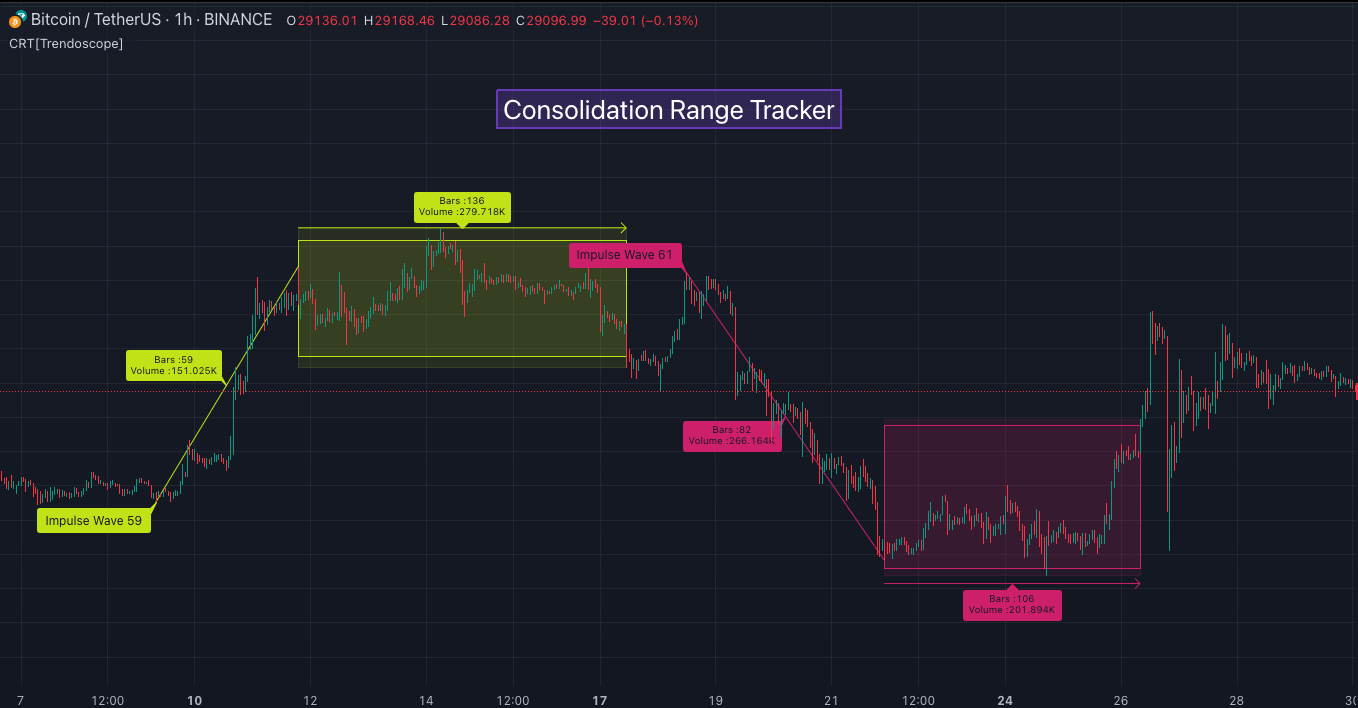Consolidation Range/Zone Tracker Indicator

Consolidation Range Tracker is an innovative indicator designed for identifying and tracking price consolidation zones following impulsive moves.
Link to the Indicator: Consolidation Range Tracker
Visualising Price Consolidation after Impulsive Moves
This indicator is built on Auto Motive Wave indicator and Interactive Motive Wave indicator. This is also an attempt to plot the Wyckoff Distribution pattern. But, instead of implying the price movement after consolidation, we are just leaving it to the interpretation of the users.
The process to derive the consolidation range
- Find impulse wave using the methods defined in Auto Motive Wave indicator and Interactive Motive Wave indicator
- Define the range of consolidation based on a predefined ratio (available as input settings)
- Track the price movement within the range along with the number of bars and cumulative volume.
- When the price breaks out of the range, check if the price ranged long enough to consider it as consolidation.
- Retain the drawings and visualisation if the consolidation is confirmed before the
- breakout. Or else, remove them from the chart to keep it clean.
Overall output can be visualised as
Note: Patterns will not be there on the chart every time. It is normal for the indicator not to show any drawings or patterns on the chart.
Stages of the Indicator
When an Impulse is formed
When an impulse wave is detected, the wave is drawn on the chart along with details such as the number of bars and volume spawning the impulse wave and the calculated range based on the input value. An alert of a new impulse is also triggered if configured for alerts.
When an Impulse is updated
When the price extends further without consolidating, the impulse wave is also updated to consider the latest values. This repaint is expected and as designed. We will also trigger an alert related to the update of an impulse wave.
Update of range as and when it happens
The range is not bound and it keeps moving based on the highest and lowest price. The value of the range is constant and it is calculated based on the certain ratio of impulse as configured in settings. But, this range can move up and down based on which direction the price moves.
For example, this is the initial range when the impulse wave is formed.
But, after certain bars, we can see that the range shifts slightly up because the price has more upward movement than downward.
No alerts are triggered during this phase.
Confirmed consolidation
The consolidation range is confirmed after the price range through certain bars with respect to the number of bars involved in the impulse wave. The default setting of 1 for the range bar ratio means that the range is confirmed when the price ranges for the same number of bars as that of impulse. An alert is triggered when the consolidation range is confirmed.
Breakout of Consolidation Range
Breakout happens if the price exceeds the range bracket. Breakout may happen either before or after confirmation of consolidation. In either case, an alert is triggered.
Patterns are removed from the chart if the consolidation is not confirmed. In other words, the price did not stay in range for a long time.
Settings of Consolidation Range Tracker Indicator
Simple settings to define the zigzag base and a few pattern-related configurations.
Theme - Helps chose the right colour of drawings for the chart background. If your chart background is dark, use the dark theme and vice versa.
Zigzag Parameters - Include length and depth of level 0 zigzag and minimum zigzag level to be considered for pattern recognition.
Range Detection Parameters - Include Range Ratio and Range Bar ratio which define the consolidation range and number of bars the price need to range to validate consolidation.
Preconfigured Alerts for Consolidation Range Tracker
Alerts are configured using the alert function and are triggered in the following scenarios.
- A new impulse created
- An impulse wave is updated
- Consolidation range confirmed
- Breakout with/without confirmed consolidation.
Possible Use Cases of Consolidation Range Tracker Indicator
The indicator can be used for identifying a few types of patterns on the chart. But, they may involve the user's discretion. Major patterns that can be identified are:
🎯 Flag Formation Consolidation after an impulse can be termed as the flag and is a sign of trend continuation after consolidation.
🎯 Wyckoff Distribution Long consolidation with high volume after an impulse can be a sign of Wyckoff distribution formation. This pattern is a trend reversal pattern.

Comments